|
|
|
Sort Order |
|
|
|
Items / Page
|
|
|
|
|
|
|
| Srl | Item |
| 1 |
ID:
174794
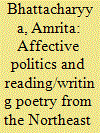

|
|
|
|
|
| Summary/Abstract |
Theorization of cultural and political issues of Northeast of India often creates a disengagement from the actual cultural performances produced in the region. This unique geo-cultural place is sometimes homogenized. In actuality, it is the home of diverse socio-cultural practices and performances. In the context of globalization, deforestation, Christianization, other internal clashes and external influences, material bodies, here, are continuously being rewritten in socio-cultural sphere. Non-representational theory considers poetry as an effective mode of exhibiting the virtual multiplicity of the nonrepresentational world. This paper will focus on exploring the corpus of Northeast Indian English poetry that focuses on social practices and bodily experiences to interpret the entire cultural flow of everyday life. As Non-representational Theory positions ‘affect’ as a central issue to individual and collective disposition in constituting the affective political discourse, this paper will also indicate some political imperatives by advancing a politics of hope in the realm of socio-political sphere.
|
|
|
|
|
|
|
|
|
|
|
|
|
|
|
|
| 2 |
ID:
174799


|
|
|
|
|
| Summary/Abstract |
A post-civil war country may cease military activity, but the social rupture impacts political discourse and ethnic relations, and can lead to collective violence against minorities. Sri Lanka has witnessed multiple examples of anti-Muslim sentiment and violence since the civil war termination, most infamously in 2014 when ethnic riots affected large numbers of people. Buddhist monks appeared to play a prominent role. The lengthy war and ethnonationalist ideologies have produced politico-religious shifts associated with ‘Buddhist extremism’, implicated in these riots and other aggressions. This paper uses interview data to explore the question: what causal mechanisms link post-civil war and extremist ideologies, and how this can lead to ethnic rioting. Interview respondents argue that promoting a monolithic national identity in a heterogeneous country enhances divisions, which can be politically expedient. An outright war victory, militarization of society and lack of peacebuilding sustain ethnic tensions that can be mobilized for further anti-minority violence.
|
|
|
|
|
|
|
|
|
|
|
|
|
|
|
|
| 3 |
ID:
174797


|
|
|
|
|
| Summary/Abstract |
This paper looks at the history of state-making in an entangled imperial frontier. The northeastern frontier of British India was a mosaic of princely states, administered and un-administered territories. The presence of the colonial state in the region was contentious, marked by violence on one hand and philanthropy on the other. The Japanese invasion of the region during World War Two had several unintended ramifications. Wartime and post-war developments produced institutions and social experiences which facilitated the process of state-making in the region. Relief and Rehabilitation project of the colonial state, and later distribution of monetary compensation was not merely governed by moral or legal obligations but was part of a larger project of imperialist reconquest in Asia after the surrender of the Japanese with Manipur and Naga Hills as the base. This project also provided the postcolonial Indian state with institutions to continue the process of state-making of its own.
|
|
|
|
|
|
|
|
|
|
|
|
|
|
|
|
| 4 |
ID:
174796
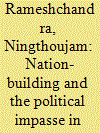

|
|
|
|
|
| Summary/Abstract |
This paper discusses the politics of India’s nationalising policies towards the ‘region’ called the ‘north-eastern region’ in general, and Manipur in particular, of the post-colonial Indian state. Such policies are informed by a two-pronged strategy, the first by militarism and the second by what I identify as developmentalism. This strategy stresses the unilateral nature of India’s nation-building projects, and how it has deliberately or inadvertently brought dissatisfaction among the native population when they have unmasked the disruptive substance of nation-building approach to this hinterland.
|
|
|
|
|
|
|
|
|
|
|
|
|
|
|
|
| 5 |
ID:
174792
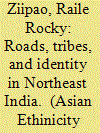

|
|
|
|
|
| Summary/Abstract |
Along with military expeditions and social and anthropological surveys, road-building projects were prominent strategies of the British in India when it came to dealing with tribes and territorialization of the frontier regions. Roads for territorial expansion and resource extraction were the core agenda of the colonial project in Northeast India. The post-colonial Indian state on the other hand built roads in the region for securing the borders, promoting national integration, and linking external markets. This article posits that road building has always been an act of power, which has at different times been aimed at smoothening relationships, securing borders, (dis)connecting people, enabling trade, creating spaces of contestation, or diluting boundaries between varied ethnic groups. The article analyzed the colonial state-making project through road construction and linked to the contemporary Indian state approach to infrastructure development in tribal-dominated areas of Northeast India.
|
|
|
|
|
|
|
|
|
|
|
|
|
|
|
|
| 6 |
ID:
174793


|
|
|
|
|
| Summary/Abstract |
Northeast India, a ‘zipper region’ that gives impetus to Southeast Asian and Himalasian studies, is marked by complexities and ambiguities. The paper examines the multiple identity construction in contemporary Assam, the central state of this region and seeks to recover the other experiences that make ethnic life-world possible while challenging the ethnocentric discourses—in academia, politics, public and social movements. Acknowledging the presence of common or possibly universal processes behind the production of such discourses, it aims to interrogate the factors that cut across socio-cultural, political-economical or ecological dimensions. It further examines the multiple discourses and narratives that makes that social possible in the region. In doing so, it locates the strategic positioning of such discourses and how they deal with Indian nation-state and beyond. This paper in essence is interested in the question of possibility of various discourses—as a question of post-history.
|
|
|
|
|
|
|
|
|
|
|
|
|
|
|
|
| 7 |
ID:
174798
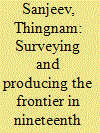

|
|
|
|
|
| Summary/Abstract |
The second half of the nineteenth century was a turning point in the history of modern Manipur when it collaborated with the British in the first Anglo-Burmese War of 1824. With the conclusion of the treaty of Yandaboo 1826, Manipur was transformed into a frontier zone. In this backdrop, the paper explores the pre-colonial notion of territory and how it competed with the European notions of space. Boundaries were fluid, and land was perceived more in terms of people and social relations. The paper also highlights the impact of state formation and territorialisation on identity formation by referring to the changes in the management of the hills and the valley after the 1891 Anglo-Manipuri War. Demarcation of land and boundaries submitted to the logic of rule and control which resulted in the classification of land and people into far more rigid categories like the separate management of the hills and the valley.
|
|
|
|
|
|
|
|
|
|
|
|
|
|
|
|
| 8 |
ID:
174800
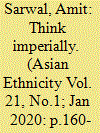

|
|
|
|
|
| Summary/Abstract |
Academic research on the White Australia Policy has spanned the history of Asian migration and policy-making initiatives in Australia. However, the role of popular transnational media images and stories of the past that inform the socio-cultural understanding of Australia–India cross-cultural relations has been under evaluated. In this paper, using unexplored archival material from popular newspaper reports and columns, I will examine the ‘goodwill visits’ of two Indian journalists, K. K. Lalkaka and Sir R. Srinivasa Sarma, to Australia in 1927 and 1947. By assessing the role of these two journalists, this paper will highlight transnational issues such as migration, ethnicity, race, class and trade between the two countries. Borrowing from Vineet Thakur’s research highlighting the role of first diplomats in the pre-independence era India, this article will contribute to the field of history in Indian diplomatic studies and historiography of Australian–Indian cross-cultural relations.
|
|
|
|
|
|
|
|
|
|
|
|
|
|
|
|
| 9 |
ID:
174795
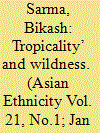

|
|
|
|
|
| Summary/Abstract |
The paper attempts to understand the genealogy of certain ‘spatial’ and conceptual dichotomies and categories pertaining to India’s North East. Representation of the geography, climate and simultaneously the dwellers of this space since middle of nineteenth century still reverberates in contemporary knowledge production about the region. These discursive practices for more than two and a half century had been (re)organizing and inscribing space, disciplining subjectivity. This problematic of representation was selectively incorporated into the biography of the ‘modern nation state’ in India that further accentuated the dichotomies and categories. The colonial dichotomy of ‘nature/culture’ staged, performed and articulated by the practices of representation enacted geographically determined social relations. These practices of representation operate not only at the level of discourse but also at the cultural, political, geographical and psychological domains. It would be crucial not only to understand the long sequence of representation but also to understand the material effects.
|
|
|
|
|
|
|
|
|
|
|
|
|
|
|
|
|
|
|
|
|